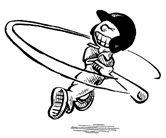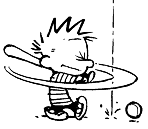
|
Physics and Acoustics of Baseball & Softball Bats
Daniel A. Russell, Ph.D. Graduate Program in Acoustics The Pennsylvania State University The contents of this page are ©2003-2011 Daniel A. Russell | 
|

|
Physics and Acoustics of Baseball & Softball Bats
Daniel A. Russell, Ph.D. Graduate Program in Acoustics The Pennsylvania State University The contents of this page are ©2003-2011 Daniel A. Russell | 
|
At the youth level (Little League Baseball and Softball) there is no distinction between a baseball bat and a softball bat. A 30-inch youth bat is the same regardless of which sport it is used for. However, at the adult level noticeable and important differences between softball and baseball bats exist. As I will try to demonstrate on this page, adult baseball and softball bats are quite different. And, even for softball bats there are significant differences between bats used for slow-pitch and fast-pitch games.
|
The most obvious difference between youth bats, softball bats, and baseball bats is length. The photo at right shows the differences in length for the same make and model bat (Demarini Vexxum) as used for (from left to right) adult baseball, adult slow-pitch softball, and youth baseball/softball. While it is true that each type of bat is available in a variety of lengths, the bats in the photo represent the most common lengths for each type. The table at right summarizes the range of lengths and the most commonly used length for each type of bat (baseball - 33", softball 34", youth - 30").
Another significant difference between youth, softball and baseball bats is the bat weight. The table at right shows the range of weights for each type of bat. The primary reason for the range of available weights is that the speed with which a player can swing a bat is somewhat related to weight, though bat swing speed is more strongly dependent on moment-of-inertia which is directly linked to the weight and length of a bat. Little League youth bats are the lightest, and have the greatest range of available weights, with composite and aluminum bats weighing much less than wood bats. For adult slow-pitch bats the most popular weight is 28oz. However, variations in the distribution of mass (and the location of the balance point) can make the apparent swing weight of 28oz bat feel much ligher or much heavier than its actual weight. Many older slow-pitch softball bats from the 1970's and 1980's were much heavier, weighing in between 34-38oz. Fast-pitch softball bats are generally lighter than slow-pitch softball bats, because the higher speed of the pitched ball means that the batter has less time to decide to commit to swing and must be able to swing the bat faster. The range of weights for adult baseball bats (which bear the BESR certification mark required for High School and NCAA college play) is much smaller because of the "minus-three" rule. One of the restrictions on bats, imposed by the NCAA to lower the performance of aluminum bats, is that the numerical value of the weight in ounces must be no more than three less than the numerical value of the length in inches. So, a 33" baseball bat could have weights of 33oz, 32oz, 31oz, and 30oz, but not 29oz. In major league baseball, where players use only wood bats, the weight of the bat is only limited by the requirement that the bat be made entirely out of solid wood, and by the fact that the handle of the bat breaks if it is made too thin. Most major league players use bats that weigh 32-34 ounces. But, some of baseball's greatest players (like Babe Ruth, Ty Cobb, Joe DiMaggio) used bats as heavy as 42oz. |

|
Same make bat (DeMarini Vexxum) offered in various models for use in adult baseball model (33" 30oz), slow-pitch softball (34" 28oz), and youth baseball (30" 20oz). |
The trampoline effect is the result of the barrel of a hollow bat squishing during the impact with the ball. The bat barrel essentially acts as a spring, storing some of the energy which would otherwise have gone into compressing the ball and been lost to internal friction forces. As the bat barrel expands it returns most of its stored energy to the ball and the resulting ball speed can be significantly higher than it would have been for a wood bat which does not have a trampoline effect. The effectiveness of the trampoline effect and the bat-ball collision depends on both the elastic properties of the bat and ball. Since the elastic properties of baseballs and softballs are considerably different, the elastic properties (the spring-like behavior of the barrel) has to be different for baseball and softball bats in order to optimize the trampoline effect. Elsewhere on my website I will discuss the physics behind the trampoline effect in greater detail. But it will suffice to say here that the barrel stiffnesses of a high performance baseball bat and a high performance softball are significantly different, with the barrels of baseball bats tending to be stiffer than softball bats. In my laboratory I measure barrel stiffness in terms of the hoop frequency and have found that higher performance bats have lower hoop frequencies.[1] A high performance softball bat will have a hoop frequency around 1200 Hz, with most ASA approved softball bats having hoop frequencies above 1500 Hz. An NCAA approved high performance adult baseball bat will have a higher hoop frequency somewhere around 1600 Hz, and hoop frequencies for most current baseball bats are above 1800 Hz. Youth bats have similar hoop frequencies as adult baseball bats. This may be a surprise since the youth bat barrels have the same diameter as softball bats. However, the barrel of a youth bat is several inches shorter than a softball bat, and the shorter barrel length results in a higher hoop frequency, or higher barrel stiffness.
References
[1] D.A. Russell, "Hoop frequency as a predictor of performance for softball bats," Engineering of Sport 5, Vol. 2, pp. 641-647 (International Sports Engineering Association, 2004). [author's preprint version (PDF)]